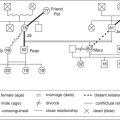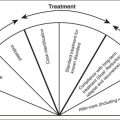Chapter 19 THE OLDER PERSON WITH CONFUSION
INTRODUCTION
The main causes of confusion among older people are dementia, delirium and amnestic disorder. These conditions are not mutually exclusive and it is not uncommon for one person to have both dementia and delirium. This chapter contains key information relevant to the assessment and management of the older person with these organic mental health problems. It should be read in conjunction with Chapter 28, which deals in more detail with the behavioural and psychological symptoms of dementia.
CLINICAL CONTEXT
CASE VIGNETTE
Mrs X, an 82-year-old widow, has been referred to the OPMHS by her daughter, who is concerned about her memory and thinking ability. The daughter says her mother has a 4-year history of insidious decline in her memory in association with word-finding difficulties and topographical disorientation. In addition, she has begun to have difficulty with instrumental activities of daily living (IADL), such as using the telephone and calculating change at the corner store. Mrs X denies any major difficulties, just saying: ‘What do you expect at my age?’ Recently, Mrs X scraped the side of another car while parking at the local shopping centre. She has also been accusing her daughter of stealing things from her house. Mrs X is reluctant to attend the outpatient clinic and her daughter has requested a domiciliary assessment.
EPIDEMIOLOGY
Amnestic disorder
Although the true prevalence of amnestic disorder is not reliably known, an Australian autopsy series found signs of the Wernicke-Korsakoff syndrome in 2.8% of brains, the highest prevalence ever reported (for a review see Harper et al 1995). However, more recent research has suggested that the fortification of flour with thiamine might have reduced the prevalence of this condition (Harper et al 1998). The syndrome of amnestic disorder is sometimes considered to be a subtype of dementia, although by definition it is not associated with the global cognitive impairment associated with dementing illnesses.
CLINICAL FEATURES
Dementia
The cardinal feature of dementia is decline from a previous level of cognitive performance involving memory and at least one of the following: aphasia, apraxia, agnosia and executive dysfunction. Aphasia is a language and communication disorder; apraxia is an abnormality of complex movement despite normal peripheral motor function; and agnosia is an inability to recognise objects despite normal sensory function. Executive dysfunction involves abnormalities in planning, organisation, initiation and checking of behaviour. In most cases of dementia, there is progressive and irreversible deterioration in cognitive function. However, some cases of dementia are caused by acute insults to the brain, such as head injury or encephalitis. In such cases, there may be the prospect of some improvement in cognitive function over several months following the acute event.
AETIOLOGY
Amnestic disorder
There are many different causes of amnestic disorder, although only one common cause in the developed world—thiamine (vitamin B1) deficiency, which is often associated with alcohol dependency. Recent research indicates that the characteristic brain changes of this focal syndrome may also be present in alcohol-dependent people who present clinically with more generalised dementia. The Wernicke-Korsakoff syndrome is at least partially reversible in many People once thiamine replacement has been implemented and alcohol intake has ceased. Uncommon causes of thiamine deficiency include bulimia nervosa, hyperemesis gravidarum (excessive vomiting during pregnancy) and chronic gastrointestinal disease. Rare causes of amnestic disorder include carbon monoxide poisoning and herpes simplex encephalitis.
ASSESSMENT
History: specific types of dementia
Dementia of the Alzheimer’s type
However, sooner or later the person develops clear evidence of insidiously worsening cognitive impairment. In most cases, this involves impaired recent memory, topographical disorientation and executive dysfunction (problems with planning and organisation particularly). This is often followed by word-finding difficulties (aphasia) and difficulties with object recognition (agnosia). As all of these symptoms get worse, the person develops more problems with instrumental activities of daily living (IADLs) and with the behavioural and psychological symptoms of dementia (BPSD). Ultimately, the person develops difficulties with even basic activities of daily living (ADLs) and requires assistance with personal care. If the person lives long enough with dementia, they become mute, doubly incontinent and unable to walk.
Stay updated, free articles. Join our Telegram channel

Full access? Get Clinical Tree





